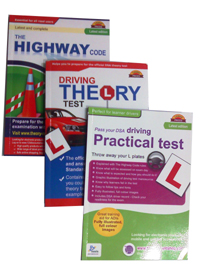hazard perception test forms a 2nd segment of the driving theory test and needs to be passed at the same time. Integrating theoretical hazard perception test into the practical training sessions will assure that as competence is reached in each of the necessary skills, they are strengthened and used while you are on the road to maximize the route safety benefits.
This portion of the theory test asks you to see 14 hazard video clips on the computer screen of about one minute each. You are asked to watch these hazard clips as if you were the driver. There will be 15 hazards to find - any on each clip. However, one clip will have 2 hazards. The hazard perception test clips will likely not contain any sound.
The following listing provides the 13 hazard groups that you should be looking for:

The official hazard perception practice video clip recommends that you click the mouse button each time you find a difference as the hazard materializes, not just once when you think you have seen it start to develop. This will ensure you score the maximum for each clip even if you click too quickly as you expect a hazard rather than responding to its development. Hence, it might be normal to click 2, 3 or possibly 4 times as the hazard evolves. However, make sure you only click in response to changes you see.
When the clip finishes the screen will turn black for a few seconds before the freeze frame for an upcoming video clip looks and the count down commences again warning you to get ready. This form is repeated until all 14 video clips have been shown.
This portion of the theory test asks you to see 14 hazard video clips on the computer screen of about one minute each. You are asked to watch these hazard clips as if you were the driver. There will be 15 hazards to find - any on each clip. However, one clip will have 2 hazards. The hazard perception test clips will likely not contain any sound.
The following listing provides the 13 hazard groups that you should be looking for:
- Pedestrians: Adults
- Pedestrians: Young adults and children
- Pedestrians: Elderly and infirm
- Zebra crossings & traffic controllers
- Horse riders & other animals
- Cyclists & motorcyclists
- Vehicles: Meeting
- Vehicles: Emerging
- Vehicles: Flashing lights
- Vehicles: Moving off
- Vehicles: Larger vehicles
- Vehicles: Reversing & U-turns
- Vehicles: Turning left or right

The official hazard perception practice video clip recommends that you click the mouse button each time you find a difference as the hazard materializes, not just once when you think you have seen it start to develop. This will ensure you score the maximum for each clip even if you click too quickly as you expect a hazard rather than responding to its development. Hence, it might be normal to click 2, 3 or possibly 4 times as the hazard evolves. However, make sure you only click in response to changes you see.
When the clip finishes the screen will turn black for a few seconds before the freeze frame for an upcoming video clip looks and the count down commences again warning you to get ready. This form is repeated until all 14 video clips have been shown.






